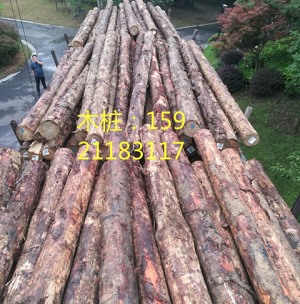According to the method of piling pine piles, it can be divided into manual piling and mechanical piling. Commonly used piling machines include hand shakers and diesel piling machines. Hydraulic excavators are also commonly used for piling. To use a hydraulic excavator for piling, two people can dig the pile and press it. Piles, push the piles into the ground to stabilize themselves at a certain depth, then let the pilings be removed, and the excavator presses the loose piles and lowers them. Generally, one piling can be done every 35 minutes, and the work efficiency is very high. In order to produce good intensive effects and improve basic support When driving piles, they must be driven with an inner ring around the base. It is recommended that the piles be placed in a plum blossom shape, and the distance between the piles should not be less than 3 times the pile diameter. After driving the piles, saw the piles according to the design height to keep the piles of each pile basically at the same level. , remove the protruding mud when digging piles, lay a 2030cm thick sand and gravel cushion on top of the piles, and then pour the bottom slab concrete.
Basically, part of the load is transferred to the soil between piles through the cushion layer, adjusting the separation effect of piles and soil. Setting a cushion layer under the foundation can reduce the pile-soil stress ratio, give full play to the effect of soil between piles, increase the beta value, and reduce The stress concentration of the basic base plate. Adjust the vertical load of the file by changing the thickness of the cushion. The thinner the cushion, the higher the ratio of the file load to the total load, and vice versa. If the cushion is not set, the pile will not function. Soil effects in between.
1) High strength, low density, and lightweight.
2) It has good elasticity and durability and can withstand impact and vibration effects.
3) Good durability under appropriate protection conditions.
4) The connection structure is easy and easy to process, and various forms of products can be manufactured.
5) Pine piles have strong hygroscopicity and swelling and shrinkage properties. When dry pine trees absorb moisture, the volume of the pine trees will expand as the adsorption number increases.
6) The structural characteristics of pine give it excellent tensile, compression, bending and shear strength.
7) Defects in pine stumps are easily visible in appearance, and wood with defects should not be used for important structures.

Related Industry Knowledge
- Methods for preventing corrosion and discoloration of fir wood piles
- Uses of radiata pine logs imported from New Zealand
- How to construct round wood piles
- Correct method of pine pile construction
- Classification of larch wood pile tube holes and transverse, radial and chordal sections
- Precautions for using fir support poles
- How to choose fir wood piles
- The solution to piling fir wood piles in rivers
- Construction of fir wood pile rockery on revetment
- Greening fir pole uses
- Some issues you should pay attention to when using pine piles
- How to use fir stakes to protect large trees
- The reason why cedar piles are widely used
- Construction method of pine piles
- How to identify the quality of fir wood piles
- The selection of fir wood piles should focus on quality
- Some issues you need to pay attention to when using pine piles
- How to keep fir wood piles fresh
- Is it necessary to take anti-corrosion measures for fir wood piles?
- How to properly construct pine piles



